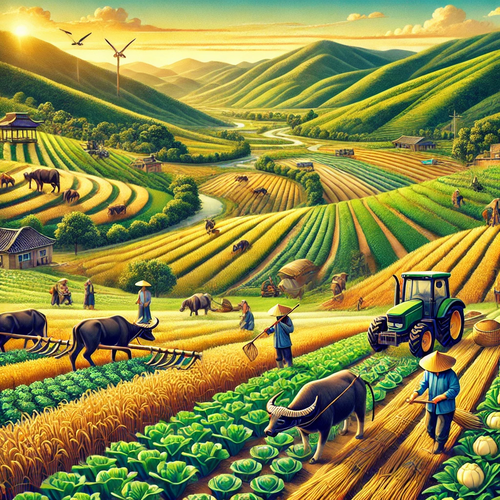
China's agriculture plays a key role in the country's economy, providing food security for more than 1.4 billion people. The sector continues to evolve and adapt to new challenges such as climate change, urbanization and demand for clean products. China is actively introducing new technologies, improving production methods and developing agricultural policies to ensure sustainability and long-term growth in agriculture.
The main areas of agriculture in China are:
1. Crops and food security
China is one of the largest grain producers in the world. Rice, wheat and corn production form the basis of the country's food security. China is also looking to increase yields using better agricultural practices and technologies such as drip irrigation systems and sustainable crops.
2. Agricultural Innovation and Technology
China is actively developing and implementing new technologies, including robotization, the use of drones and artificial intelligence to monitor farmland. Genetic modification of plants is also actively used to increase disease resistance and improve crop quality.
3. Sustainable agriculture
In recent years, China has focused on developing sustainable agriculture. The introduction of environmentally friendly technologies such as organic farming, agroforestry and agricultural waste recycling helps minimize the environmental impact of agriculture.
4. Animal husbandry and aquaculture
Animal husbandry, especially pork, milk and egg production, forms an important part of Chinese agriculture. In recent years, China has also been actively developing aquaculture, becoming the largest producer of fish and seafood in the world.
5. Rural modernization
China invests in rural modernization, improving infrastructure, health and education, as well as creating new jobs and supporting farmers through subsidies and support programs.
Growth and sustainability drivers:
- Government support and programs
The Chinese government actively supports the agricultural sector through subsidies, innovation programs and infrastructure improvements. Special government initiatives are aimed at increasing productivity, improving food security and developing sustainable production methods.
- Digitalization and Agrotechnologies
In recent years, China has significantly increased the use of digital technologies in agriculture. The development of smart farms, the use of sensors, IoT and blockchain technologies to improve logistics and track product quality is becoming an integral part of agrarian reform.
- Partnerships with international companies and knowledge sharing
China actively cooperates with international partners in the field of agriculture, adopting best practices and introducing the latest technologies. This helps to increase efficiency and reduce costs in agriculture.
The future of China's agriculture is linked to a shift to more sustainable, high-tech and environmentally friendly production methods. The country will continue to modernize the agricultural sector, introducing new technologies and practices to improve food security and improve the lives of the rural population.
The main areas of agriculture in China are:
1. Crops and food security
China is one of the largest grain producers in the world. Rice, wheat and corn production form the basis of the country's food security. China is also looking to increase yields using better agricultural practices and technologies such as drip irrigation systems and sustainable crops.
2. Agricultural Innovation and Technology
China is actively developing and implementing new technologies, including robotization, the use of drones and artificial intelligence to monitor farmland. Genetic modification of plants is also actively used to increase disease resistance and improve crop quality.
3. Sustainable agriculture
In recent years, China has focused on developing sustainable agriculture. The introduction of environmentally friendly technologies such as organic farming, agroforestry and agricultural waste recycling helps minimize the environmental impact of agriculture.
4. Animal husbandry and aquaculture
Animal husbandry, especially pork, milk and egg production, forms an important part of Chinese agriculture. In recent years, China has also been actively developing aquaculture, becoming the largest producer of fish and seafood in the world.
5. Rural modernization
China invests in rural modernization, improving infrastructure, health and education, as well as creating new jobs and supporting farmers through subsidies and support programs.
Growth and sustainability drivers:
- Government support and programs
The Chinese government actively supports the agricultural sector through subsidies, innovation programs and infrastructure improvements. Special government initiatives are aimed at increasing productivity, improving food security and developing sustainable production methods.
- Digitalization and Agrotechnologies
In recent years, China has significantly increased the use of digital technologies in agriculture. The development of smart farms, the use of sensors, IoT and blockchain technologies to improve logistics and track product quality is becoming an integral part of agrarian reform.
- Partnerships with international companies and knowledge sharing
China actively cooperates with international partners in the field of agriculture, adopting best practices and introducing the latest technologies. This helps to increase efficiency and reduce costs in agriculture.
The future of China's agriculture is linked to a shift to more sustainable, high-tech and environmentally friendly production methods. The country will continue to modernize the agricultural sector, introducing new technologies and practices to improve food security and improve the lives of the rural population.
